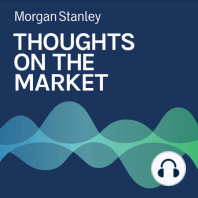4 min listen

ESG: How will Evolving Regulations Affect Investment?
ESG: How will Evolving Regulations Affect Investment?
ratings:
Length:
6 minutes
Released:
Oct 19, 2022
Format:
Podcast episode
Description
As the EU puts new regulations on sustainability funds, how will categorization of these funds be impacted, and how might that change investment strategies? Head of Global Thematic and Public Policy Research Michael Zezas and Head of Fixed Income and ESG Research Carolyn Campbell discuss.----- Transcript -----Michael Zezas: Welcome to Thoughts on the Market. I'm Michael Zezas, Morgan Stanley's Head of Global Thematic and Public Policy Research. Carolyn Campbell: And I'm Carolyn Campbell, I lead our Fixed Income and ESG Research Team. Michael Zezas: And on this special episode of Thoughts on the Market, we'll focus on sustainability funds and their investment strategies within an evolving regulatory context. It's Wednesday, October 19th, at 10 a.m. in New York. Michael Zezas: There are just over 1400 dedicated fixed income sustainability funds with assets under management, around $475 billion off from a peak of $545 billion at the end of 2021. This is a sizable market, but as EU regulators weigh in on what these funds can and can't own, it begs the question what kinds of bonds might they start buying? So Carolyn, let's maybe start with the essentials behind the EU Sustainable Finance Disclosure Regulation, SFDR, and what it requires of financial market participants. Specifically, what are Article 8 and Article 9 products? Carolyn Campbell: So under the SFDR, fund managers are required to classify their funds in one of three ways. The first, Article 8, or what's known as a light green fund, is a sustainability fund that promotes environmental or social characteristics. The dark green funds, which are Article 9 funds, invest in sustainable investments and have an environmental or a social factor as an objective. They also, importantly, cannot do significant harm to other environmental or social objectives. And then lastly, we have the non sustainability funds which are Article 6. Michael Zezas: And despite the regulator's goal to increase transparency and accountability, there's still a high degree of uncertainty in the regulatory landscape around what can and should be included in sustainability funds. What does this uncertainty mean for the types of products that are currently being included in these funds, and how might that change in the future? Carolyn Campbell: So by and large, the regulatory uncertainty has meant that funds are more likely to take a conservative approach when constructing their holdings for fear of regulatory repercussions or just reputational risk. In particular, where investors need to have a "sustainable investment" that does not do significant harm to other environmental objectives, which is what we have in Article 9, we expect to see them gravitate increasingly towards high quality green bonds. And as a reminder, green bonds are different from regular bonds because the net proceeds of those bonds goes towards green projects. Think of it as retrofitting buildings to be more environmentally friendly, investing in climate change adaptation solutions, or building out clean transportation infrastructure. Green bonds fit pretty neatly into these Article 9 funds because they're demonstrably sustainable investments. And since you know where the proceeds are going, it's less likely that they're violating that last part, the ‘do no significant harm’. So some of the Article 9 funds are full green bond funds. But the ones that are not actually only hold around an average of 10% of their fund in green bonds or other types of ESG label bonds like social or sustainability bonds. And we see similar figures in the Article 8 funds as well. So we expect that green bonds of higher quality, meaning that they're aligned with the more rigorous EU green bond standard that report on impact have limited amounts of proceeds going towards refinancing, have limited look back periods etc.. Those stand to benefit from an increased appetite from these sustainability funds for the best types of green bonds. Michael Zezas: Carolyn, yo
Released:
Oct 19, 2022
Format:
Podcast episode
Titles in the series (100)
Andrew Sheets: A Second (and Third) Opinion for Equity Markets by Thoughts on the Market